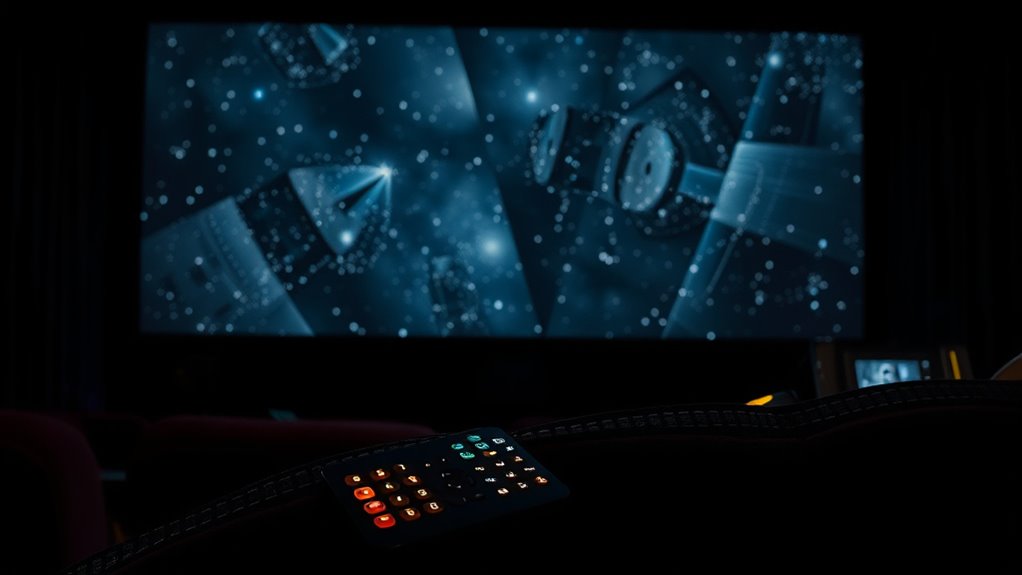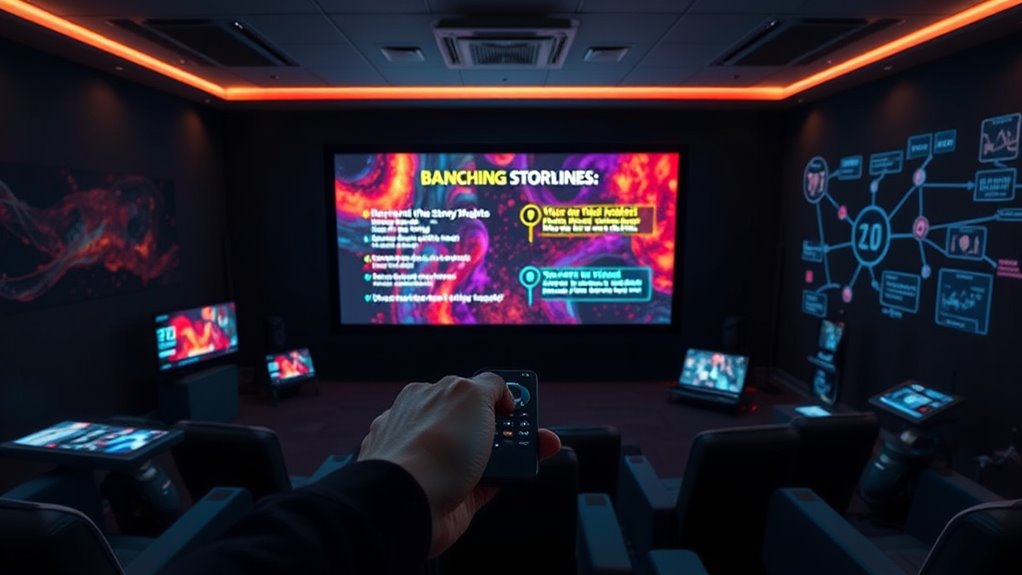Interactive films let you influence the story through choices, turning passive watching into an active experience. Unlike traditional movies with fixed plots, these films offer branching paths and personalized outcomes, deepening your emotional engagement. Using advanced technology like AI, VR, and multimedia tools, creators craft immersive stories that adapt to your decisions. Curious about how this innovative storytelling idea continues to evolve and shape the future? Keep exploring to discover more about this exciting trend.
Key Takeaways
- Interactive films allow viewers to influence the story through choices, creating multiple possible outcomes and personalized experiences.
- They shift traditional passive viewing to active participation, increasing emotional engagement and investment.
- Technologies like AI, VR, and game engines enable real-time story adaptation and immersive branching narratives.
- This trend enhances storytelling depth, supports educational and marketing applications, and challenges conventional linear formats.
- The rise of interactive films signifies a shift towards more participatory, personalized, and immersive cinematic experiences.
The Evolution of Storytelling in Cinema

The evolution of storytelling in cinema has continually pushed the boundaries of how stories are told and experienced. As filmmakers explore more complex narratives, you gain a deeper level of engagement and understanding. Narrative complexity has increased, inviting you to piece together intricate plots and uncover hidden meanings. At the same time, audience agency has become more prominent, allowing you to influence the story’s direction through choices and interactions. This shift transforms you from a passive viewer into an active participant, shaping the narrative’s outcome. Over time, cinema has moved from straightforward storytelling to immersive, layered experiences that challenge your perception and involvement. This evolution reflects a desire to create richer, more personalized stories that resonate on a deeper level. Recognizing emotional support can enhance your connection to stories, making experiences more meaningful and impactful.
How Interactive Films Differ From Traditional Movies

While traditional movies present a fixed story that unfolds in a linear way, interactive films invite you to influence the narrative through your choices. This shift transforms storytelling into multimedia experiences, blending film with elements like branching paths and decision points. Unlike standard movies, where the plot remains the same for everyone, interactive films offer multiple storylines, increasing narrative complexity. Your decisions directly shape the outcome, making each viewing unique. This approach engages you more deeply, turning passive watching into active participation. It also allows creators to craft layered, dynamic stories that adapt based on your interactions. Moreover, as AI technologies advance, the development of interactive storytelling becomes more sophisticated, enabling even more immersive and personalized experiences. In essence, interactive films blend the art of cinema with innovative storytelling techniques, creating immersive experiences that challenge traditional narrative boundaries.
The Technology Behind Choose-Your-Own-Ending Films

Choose-your-own-ending films rely on sophisticated technology to seamlessly present different story paths based on your decisions. Augmented reality enhances interactivity by overlaying digital choices onto real-world views, creating immersive experiences. Neural networks power the storytelling by analyzing your choices and predicting the most engaging next steps, guaranteeing smooth transitions between scenes. These AI-driven systems adapt in real-time, allowing a dynamic narrative that responds to your input. Video game engines like Unity or Unreal Engine serve as the backbone, managing complex branching storylines efficiently. This combination of augmented reality and neural networks makes the experience feel natural and personalized, giving you control over the story’s outcome without disrupting the flow. The technology guarantees a seamless, engaging experience tailored to your decisions. Additionally, contrast ratio plays a crucial role in ensuring that visuals are vibrant and clear, especially when displaying complex scenes and multiple story branches.
Popular Examples of Interactive Films and Series

Many interactive films and series use branching narratives to keep viewers engaged, offering choices that shape the story’s outcome. You might recognize popular examples like “Black Mirror: Bandersnatch” or certain Netflix series that let you decide characters’ fates. These works demonstrate how interactive storytelling has become a compelling way to experience media. This trend reflects the broader rise of interactive media as a popular format in modern entertainment.
Branching Narratives in Gaming
| Choice Point | Emotional Impact |
|---|---|
| Saving a character | Love, guilt, redemption |
| Betraying a friend | Trust, regret, betrayal |
| Moral dilemma | Courage, fear, conviction |
| Sacrifice decision | Honor, loss, sacrifice |
| Revealing secrets | Trust, suspicion, revelation |
Notable Interactive Series
Have you ever wondered which interactive series have captivated audiences and set the standard for choose-your-own-adventure storytelling? Titles like Netflix’s “Black Mirror: Bandersnatch” revolutionized interactive storytelling by giving viewers real agency over the plot’s direction. “Unbreakable Kimmy Schmidt: Kimmy vs. the Reverend” offers similar viewer agency, blending comedy with decision-based navigation. “Game of Thrones: A Telltale Series” immerses players in political intrigue, emphasizing meaningful choices. These series stand out because they empower you to shape the narrative, making each experience unique. They demonstrate how interactive storytelling can deepen engagement and immersion, ensuring viewers are active participants rather than passive spectators. These notable examples continue to influence the evolution of interactive films and series, highlighting their growing popularity and potential.
The Audience Experience: Engagement and Personalization

How do interactive films deepen your connection to the story? By offering audience immersion and personal storylines, these films make you feel truly involved. You get to influence outcomes, making the experience unique to you. Personalization heightens emotional investment and keeps you engaged longer. When your choices impact the plot, you see the story through your lens, creating a sense of ownership. This level of engagement transforms passive viewing into active participation. Additionally, vetted content ensures a safe and enjoyable experience for viewers of all ages.
Challenges and Limitations of Interactive Filmmaking

Despite the innovative appeal of interactive films, they face significant challenges that can hinder their widespread adoption. High production costs create budget constraints, as developing multiple story paths, creating interactive elements, and ensuring seamless user experience demand more resources than traditional films. Additionally, viewer fatigue becomes a concern; constantly making choices can overwhelm or frustrate viewers, reducing engagement over time. If the experience feels too complex or repetitive, audiences might lose interest quickly. Technical limitations also pose problems, such as ensuring smooth navigation across choices and maintaining high-quality visuals. These hurdles can make studios hesitant to invest heavily, limiting the growth of interactive filmmaking. Overcoming these challenges requires balancing creative innovation with practical constraints to make interactive films sustainable and appealing.
The Future of Interactive Narratives in Entertainment

The future of interactive narratives in entertainment is poised to transform how you experience stories by blending cutting-edge technology with immersive storytelling techniques. As these innovations evolve, you’ll see more personalized experiences that increase user engagement and deepen narrative complexity. Interactive platforms will leverage AI and virtual reality to create seamless, responsive worlds tailored to your choices. This integration of encryption solutions and cybersecurity measures will ensure data privacy and secure interactions within these immersive environments. This will make stories more dynamic and unpredictable, encouraging exploration and emotional investment.
Interactive narratives will become more personalized, dynamic, and immersive through AI and VR technologies.
- Enhanced AI-driven characters for realistic interactions
- Greater integration of VR/AR for immersive worlds
- Adaptive storytelling based on player behavior
- More layered, multi-threaded storylines
- Increased accessibility for diverse audiences
These advancements promise richer, more engaging experiences that redefine how you connect with stories.
Why Interactive Films Are Reshaping Visual Storytelling

Interactive films are transforming visual storytelling by putting you directly in the driver’s seat, allowing you to make choices that shape the narrative’s direction. This interactivity isn’t limited to entertainment; it’s also revolutionizing interactivity in education, engaging learners through immersive, decision-based content. In marketing, narrative branching helps brands connect with audiences by creating personalized experiences that adapt to your preferences. These techniques make stories more engaging and memorable, fostering deeper emotional connections. By empowering viewers to influence outcomes, interactive films challenge traditional storytelling norms, making narratives more dynamic and participatory. This shift not only enhances viewer engagement but also opens new avenues for education and marketing, demonstrating how interactive films are reshaping the future of visual storytelling across various industries. Moreover, integrating attention into interactive experiences can significantly boost engagement and retention, leading to more impactful storytelling.
Frequently Asked Questions
How Do Writers Craft Multiple Storylines Simultaneously?
You craft multiple storylines by developing a branching narrative, where each choice leads to a different path. To manage this, you focus on script complexity, mapping out all possible options and outcomes early on. This process involves careful planning and organizing scenes so that each decision point smoothly shifts into the next. By staying organized, you guarantee that every storyline remains coherent, engaging, and seamlessly interconnected throughout the experience.
What Are the Costs Associated With Producing Interactive Films?
Did you know that interactive films can cost up to 30% more to produce than traditional movies? When you consider this, you see that the costs involve more than just money. Budget constraints make it harder to fund multiple storylines, and technical challenges require extra resources for seamless choices and outcomes. These factors increase production complexity, demanding more time, skilled talent, and advanced technology to create engaging, interactive experiences.
How Do Interactive Films Impact Traditional Filmmaking Careers?
You might notice that interactive films impact traditional filmmaking careers by shifting focus toward branching narratives and viewer agency. As these films demand new skills and storytelling techniques, you could find opportunities in areas like game design, scriptwriting, and interactive content creation. However, it also challenges conventional roles, requiring you to adapt to evolving technologies and audience expectations, ultimately transforming how stories are told and experienced in the industry.
Are There Accessibility Concerns With Choose-Your-Own-Ending Films?
You might wonder if choose-your-own-ending films raise accessibility concerns. They can, especially if screen reader compatibility isn’t prioritized or if the user interface design is confusing. To guarantee everyone can enjoy these films, creators need to optimize navigation and make sure screen readers work seamlessly. When done right, these films become more inclusive, allowing audiences with diverse needs to participate fully in the interactive experience.
Can Interactive Storytelling Be Effectively Integrated Into Virtual Reality?
You can effectively integrate interactive storytelling into virtual reality by creating a branching narrative that enhances the immersive experience. VR allows you to explore different story paths naturally, making choices feel real. This technology empowers you to become part of the story, deepening emotional engagement. By designing seamless progressions and rich environments, developers can harness VR’s potential to deliver compelling, personalized stories that captivate and involve you fully.
Conclusion
As you explore the world of interactive films, you see how they’re changing the game and opening new doors for storytelling. With technology advancing, these films put you in the driver’s seat, making each experience unique. While there are hurdles to overcome, the potential is huge—it’s like turning the page to a fresh chapter. You’re witnessing a revolution where your choices truly shape the story, proving that the future of entertainment is anything but set in stone.









